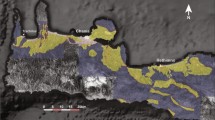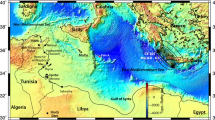Abstract
The Chott el Djerid is a large, salt-covered depression in southern Tunisia (Fig. 1). The late nineteenth century idea that the basin had been invaded by the sea1,2 has been superseded by the view that any Quaternary flooding of the Chott must have resulted from climatic changes, as the fossils found in its sediments are not exclusively marine and there is no indication of the fluctuations in sea level or of the crustal movements that would be required to fill and then empty the basin2,3. We report here evidence for a marine connection 35,000–25,000 years ago and show that it implies subsequent uplift by some 80 metres in an area long regarded as either stable2 or prone to subsidence throughout the Quaternary4.
This is a preview of subscription content, access via your institution
Access options
Subscribe to this journal
Receive 51 print issues and online access
$199.00 per year
only $3.90 per issue
Buy this article
- Purchase on Springer Link
- Instant access to full article PDF
Prices may be subject to local taxes which are calculated during checkout
Similar content being viewed by others
References
Lesseps, F. de Rev. Scient. 21, 495–496 (1883).
Coque, R. La Tunisie Présaharienne (Colin, Paris, 1962).
Coque, R. & Jauzein, A. in Guidebook to the Geology and History of Tunisia, 227–257 (Petroleum Exploration Society of Libya, Tripoli, 1967).
Burollet, P. F. Annls Mines Géol. Tunis 18, 1–345 (1956).
Milokhoff, E. C.r. XIXe Congr. géol. int., Alger 15, 337–339 (1954).
Page, W. D. thesis, Univ. Colorado (1972).
Gaillard, J. M. & Testud, A.-M. in The Geology of Libya Vol. 3 (eds Salem, M. J. & Busrewil, M. T.) 809–813 (Academic, London, 1980).
Gaven, C., Hillaire-Marcel, C. & Petit-Maire, N. Nature 290, 131–133 (1981).
Petit-Maire, N., Casta, L., Delibrias, G., Gaven, C. & Testud, A.-M. in The Geology of Libya Vol. 3 (eds Salem, M. J. & Busrewil, M. T.) 797–807 (Academic, London, 1980).
Zaouali, J. Bull. off. natn. Pêch. Tunisie 3, 107–140 (1979).
Domergue, Ch., Dumon, E., De Lapparent, A. F. & Lossel, P. C.r. XIXe Congr. géol. int., Alger, Monogr. rég. Tunisie 7 (1952).
Gobert, E. G. Quaternaria 6, 271–307 (1962).
Millman, J. D. Marine Carbonates (Springer, New York, 1974).
Chappell, J. & Veeh, H. H. Nature 276, 602–603 (1978).
Fontes, J.-C. & Perthuisot, J.-P. Nature 244, 74–75 (1973); Rev. géog. Phys. géol. Dyn. 13, 299–314(1971).
Castany, G. Geol. Rdsch. 43, 196–203 (1955).
Dalongeville, R., Paskoff, R., Sanlaville, P., Thommeret, J. & Thommeret, Y. C.r. hebd. Séanc. Acad. Sci., Paris D290, 303–306 (1980).
Author information
Authors and Affiliations
Rights and permissions
About this article
Cite this article
Richards, G., Vita-Finzi, C. Marine deposits 35,000–25,000 years old in the Chott el Djerid, southern Tunisia. Nature 295, 54–55 (1982). https://doi.org/10.1038/295054a0
Received:
Accepted:
Issue Date:
DOI: https://doi.org/10.1038/295054a0
This article is cited by
-
Phylogeography of Aphanius fasciatus (Osteichthyes: Aphaniidae) in the Mediterranean Sea, with a focus on its conservation in Cyprus
Hydrobiologia (2021)
-
Chronology of the major palaeohydrological events in NW Africa during the late Quaternary: PALHYDAF results
Hydrobiologia (1991)
-
Holocene evolution of lakes
Nature (1985)
Comments
By submitting a comment you agree to abide by our Terms and Community Guidelines. If you find something abusive or that does not comply with our terms or guidelines please flag it as inappropriate.



